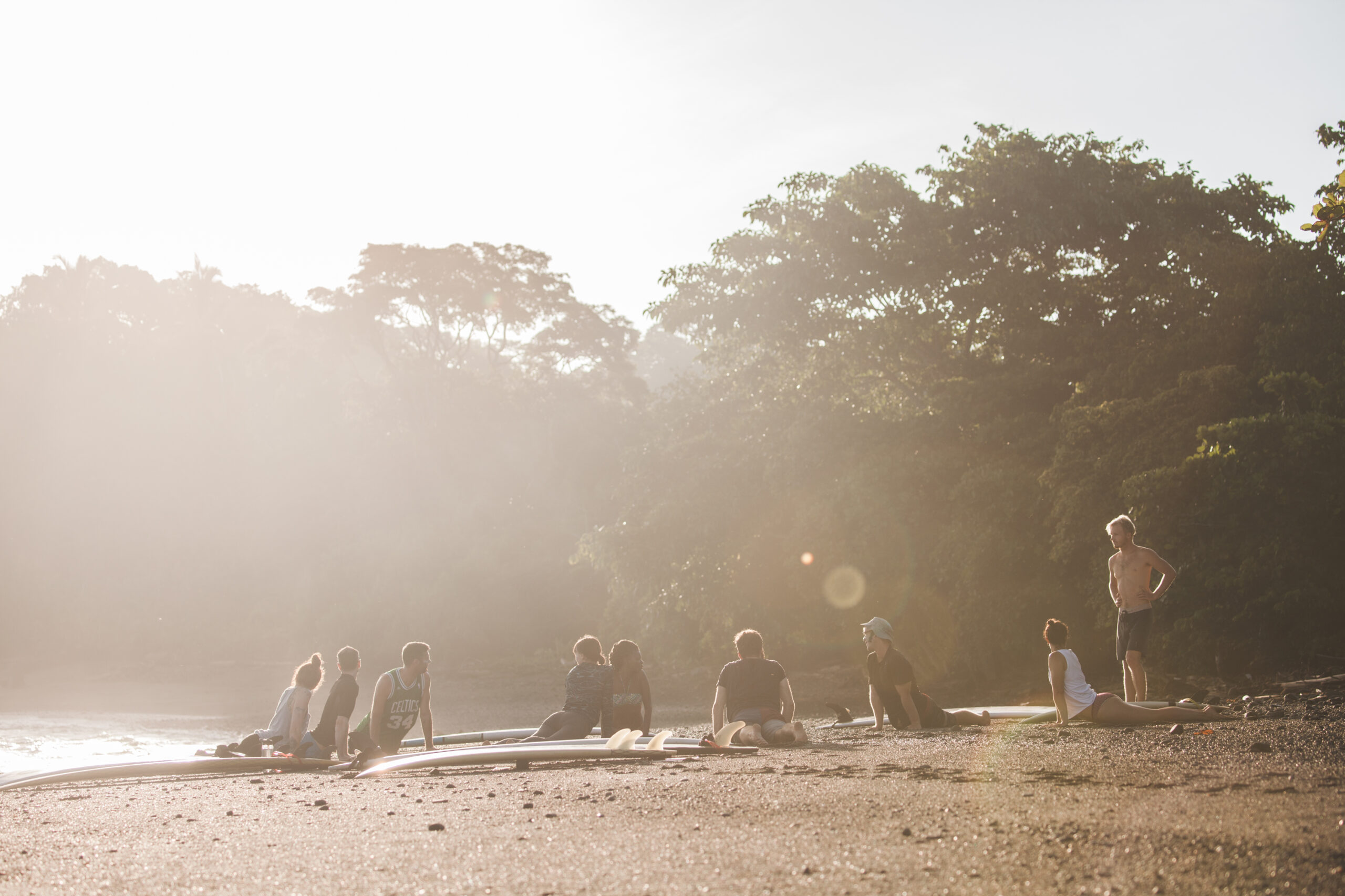
12 Jul How to prepare for Your First Surf Lesson
Getting ready for your first surf lesson?
We’ve put together a list of quick and easy tips to get the most of it!
Who doesn’t enjoy a peaceful vacation by the ocean, sand, and sunshine? It’s a fantastic opportunity to explore a new sport, and there’s nothing quite like surfing in the sea
Many of us have fond memories of watching smooth surfers in movies when we were younger.
And, most of us have tried to do the same.
But even though it might seem easy to ride the waves with style, you quickly realize that it’s not as easy as it looks.
While these individuals look incredibly cool while surfing on the water, you look more like a fish out of water.
But, wait! Don’t let that put you off.
Just remember that Rome wasn’t built in a day and these smooth and cool surfers were once awkward like you are now.
With some great tips and tricks, you’ll soon find yourself popping up on the board instead of wiping out in the water.
In this article, you’ll find 10 actionable tips to get started with your first surf lesson: 4. Start with the basics – the pop-up technique 6. Wear the appropriate attire 8. Read to get familiar with the common terms So, let’s get started! Not everyone gets it the first time, but if you want to ace your first surf lesson, there’s tips you can try. By keeping these things in mind, you’ll be soon riding the waves like a pro. When it comes to trying out something new for the first time, it’s normal to be nervous and awkward. The same goes for learning how to surf for the first time. Before you start your surf journey, you must have a can-do attitude and willingness to learn new skills. Moreover, set aside all negative feelings and doubts about not being able to learn. Also, be with an open mind and get ready to give your 100% to get the most out of the surf lesson. You’ll be popping up on that board in a flash. Surfing is amazing because it helps you enjoy the moment when you’re just starting your first surf lessons. But don’t expect too much. Moreover, don’t think you’ll be fantastic during your first surf lessons either or that you won’t ever make mistakes. Remember, it’s okay to slip up while you’re learning during your first surf lesson. However, try to release any fear or doubts and concentrate on the current moment during your first surf lesson. In the end, the best surfer is the one who has the most fun during their first surf lesson. As your concerns go away, you’ll find yourself riding the waves with a big smile. Then, you’ll start feeling comfortable during your first surf lessons… and making lasting memories. As we often say, ‘It’s all about having a great time during your first surf lessons and feeling like a carefree kid!'”
Surfing is incredibly exciting, but it’s very physically demanding. Before your first surf lessons, it’s important to be physically prepared. In addition, surfing requires various physical abilities, like paddling, catching waves, and maintaining balance on your board. Think about it this way: imagine preparing for a marathon. Unfortunately, marathon training won’t help much with surfing. For instance, if you enjoy jogging, try running fast for one minute, then jog for three minutes, and repeat this cycle. After that, if you have access to a pool, swim as fast as you can for around 30 seconds, followed by a two-minute slow swim to recover, and repeat. By then, paddling and quickly getting on your board become crucial in your first surf lessons, needing significant upper body strength. Before your surf camp, consider hitting the gym to work on your shoulders, back, chest, and arm muscles. But remember, don’t overexert yourself, and always incorporate stretching to prevent soreness. Effective surf training allows you to catch more waves, stay in the water longer, and minimize the risk of injuries after a fall. Hence, the best surf training is, of course, more surfing. But if you don’t have access to the ocean, your own surf training can help you make the most out of your surf holiday. Moreover, it enhances your ability to ride waves and enjoy a great surf session.
The first step that you’re probably going to learn in your surf lesson is how to stand up on the surfboard. Popping up on your board is something that you can easily practice by yourself — without any coach, waves, or even a surfboard! Furthermore, your surf camp will introduce you to a number of tips on how to master the pop-up technique. But until you get there, you can practice it on a yoga mat at home. Draw a straight line and make sure your feet land in the middle of that line. And, here comes the best part: Practicing the pop-up technique will not only prepare you better for the surf lesson, but you can also incorporate it into your interval workout! Developing the muscles you need to pop up fast and efficiently will help you enjoy your surfing experience within no time.
If you’re a surfer, it’s very very important to know about rip currents and their impact on your surfing experience. A rip current is a powerful, fast-moving water current that flows directly away from the shore, cutting through waves. These currents can move at speeds of up to 8 feet per second, faster than an Olympic swimmer. Even the strongest swimmers can be carried far from the shore by a rip current. Although lifeguards in the US rescue thousands of people from rip currents each year, approximately a hundred people lose their lives to them annually. These data is not meant to scare you, but to focus on the importance of understanding what rip currents are and how to stay safe. Some telltale signs of a rip current include a line of seaweed slowly moving out to sea, a rough channel of water, or a disrupted pattern of incoming waves. Tip: The best strategy is to not fight the current. Instead, swim parallel to the shore or follow the current out. It’s important to be able to recognize a rip current and, if need be, know how to escape one safely.
If you get caught in the current, it’s natural to feel like swimming against it and back to the shallow water. But, this won’t work as the sea is definitely stronger than you, no matter how good a swimmer you are.
Tip: Before you get in the water, remember to have a point of reference on the beach (like a tall tree, a flag or a lifeguard chair). This will allow you to be able to notice if the water is taking you out of your desired position in the water.
If you’re at a surf spot where the water is cold, you’ll need to wear a wetsuit for your surf lessons. During different months of the year, some regions in Central America can see their water temperature vary greatly due to strong winds. Tip: Find out about the water temperature by calling your surf camp before the trip. This will help you make sure you have the right attire during your trip. Also, make sure that you wear the right wetsuit for your lesson:
Girls, ensure that the swimsuit fits you properly. Because if your attire is too loose, you’ll be thinking on not getting a wardrobe malfunction when all your attention should be on catching that wave. Tip for girls: Try to find a good swimsuit for surfing and not the sexy one piece tiny swimsuits you see on Instagram. Next, if you’re travelling to a tropical country, get a rash guard or a tight t-shirt. What’s more, it will help you protect your chest from the irritation of the wax and the board along with protecting your upper body from turning lobster red. Did you know that about 90% of non-melanoma skin cancers are related to exposure to ultraviolet (UV) radiation from the sun? To avoid any risk, wear sunscreen before you ride the waves. Not only does it protect your skin, It also helps prevent any skin burns and, worse, skin cancer. Oh, and don’t put it JUST before going in the water because it won’t be so useful. Sunscreen takes at least 15 minutes to be absorbed by your skin to be helpful. (yes, it’s written in the instructions on the bottle) The kind of sunblock you choose must be water proof, specifically made for water sports, and it should guard against both UVA and UVB rays. It usually works for 80 minutes. So it’s best to wear a rash guard, especially if you’re running away from the Northern winter. We highly recommend not using any normal sunscreen for your face. It will eventually leak and burn your eyes. Tip: Use Zinc face stick to protect your face from the sun. There are many different kinds of brands. From organic zinc paste made with cacao like Surf Yogi or Manda to traditional surf zinc that’s been around for years like Head Hunter. Ask your surf camp where you can buy this product, as it may be difficult to find in your hometown if you’re not close to the sea.
Eating well doesn’t mean eating until you’re stomach is full. Surfing is a very tiring activity and you’ll need to properly feed your body so that it can handle even one hour of physical activity. Avoid eating oily and greasy fast food. Just like eating too much, not eating enough could be bad too. Consuming too little could also lead to fatigue. So take a satisfying, healthy meal of good carbs. Not sure what to eat? A bowl of whole wheat oats or grain cereal with some fresh fruits would work well. (Psst…..find out what Kelly Slaters eats for breakfast to surf like a king in his mid-40s) You’ll find plenty of learning guides and surfing vlogs over the internet. So, go online and read the basics of surf lessons. We have a list of useful articles on our blog here. You might not remember everything written in these blogs but that’s okay. Just try to introduce yourself with the basics. This way, you’ll be fairly familiar with what occurs in the first surf lesson. You may, later on, recall all that you’ve read at some point during your surf training. Don’t worry if you don’t understand everything. Just ask your trainer about it, that’s why he’s there.
Here’s how you can plan your trip ahead in time to avoid any last minute fails: Want to save money without losing any fun? Avoid planning your trips around holidays such as Christmas, New Year, and Spring Break etc. Typically, flights get super expensive during the holiday season.
Do you prefer surfing in warm water? Or, would you like to ride the waves with the cold breeze flowing around you? Keep in mind that in cold water you’ll have to wear a wetsuit. This means you’ll be carrying extra weight when paddling. How long of a vacation you can get off work? Can you afford to go all the way to Asia and spend 2-3 days of flight time? If your holiday time is limited and you want to surf as much as possible then flying to Central America might be a better option! Do you want your holiday to be focused mainly on surfing (so that you may surf as much as possible)? Then, choose surf lessons with only a few other students. When learning in a small group, your coach can give you individual review between waves so that you can improve fast. On the other hand booking your surf trip in a busy hostel where people are not necessarily focused on surfing might ruin your experience. Especially if you want to focus your holiday on learning how to surf. Serious about wanting to learn how to surf? Check out our surf camp retreats in Costa Rica If your first surf lesson goes successful, you might feel encouraged to cruise alone. But, regardless of how confident you feel after your lesson, don’t move too far away from your fellow surfers. As a new surfer, you need to stay close to your pack. Waves conditions can change quickly from one day to another. The quiet smooth little waves session you had the day before can become big waves you . Tip: Assess the surf spot with someone of experience before going on your own. A general rule of thumb is: Don’t paddle out if you’re not 100% sure you can make it back to the beach without your board, swimming by yourself (in case you lose your board out there). Find information about the spot, the tides and the local crew surfing there. You certainly want to be careful not to be at the wrong place at the wrong time and piss off the more skilled surfers. This could ruin both your and their experience. If you’ve got some free time after the lesson and you want to have fun in the water, ask your surf coach if he feels you’re ready to go by yourself. And then ask some fellow students to join you. It’s better than taking the risk of going alone in a place where you don’t know… The key to learn surfing is not to stress out to much over your first surf lesson. It’s not a competition and everyone should go at their own pace. Remember, the whole learning process is supposed to be fun and exciting. So, join your first surf lesson with the right state of mind, be prepared to learn new things, fall and try again. Practice makes perfect! This is why we usually surf 4-5h per day during our surf coaching retreats. Now that you know how to be at your best for your first surf lesson, read this article next to find the best surf spots to start surfing . Looking to get inspired for your very first surf lesson? Check out our post with 40 inspirational surf quotes.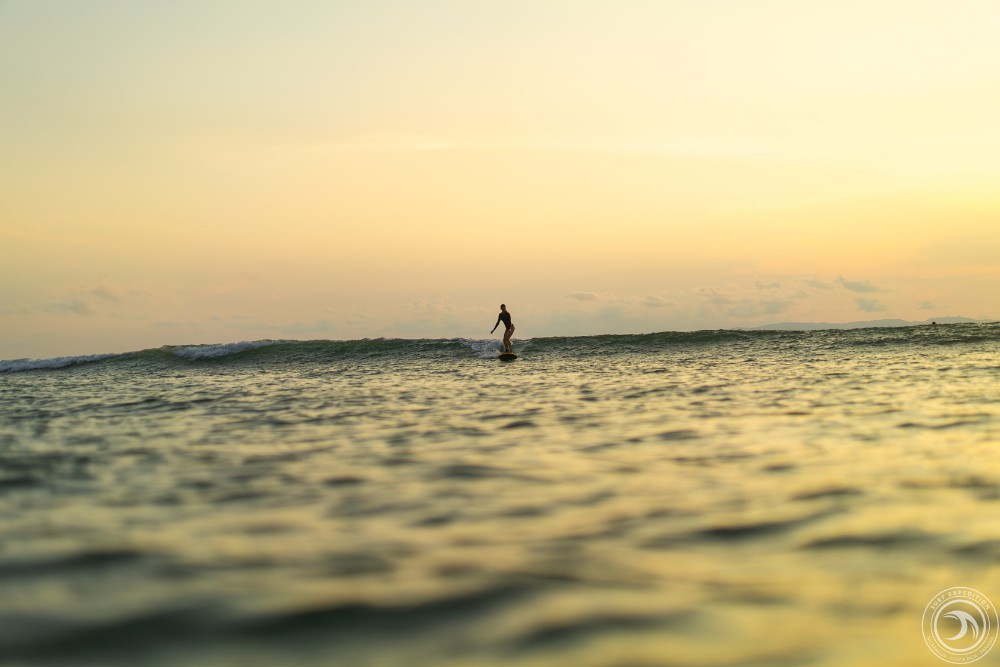
Things You Need to Know Before Your First Surf Lesson
1. Dive in with an clear mind and a positive attitude

2. Trust the process and leave everything else behind
3. Focus on your physical fitness
Tip: Surfing involves short bursts of intense physical effort and adrenaline rushes, so focus on high-intensity workouts.
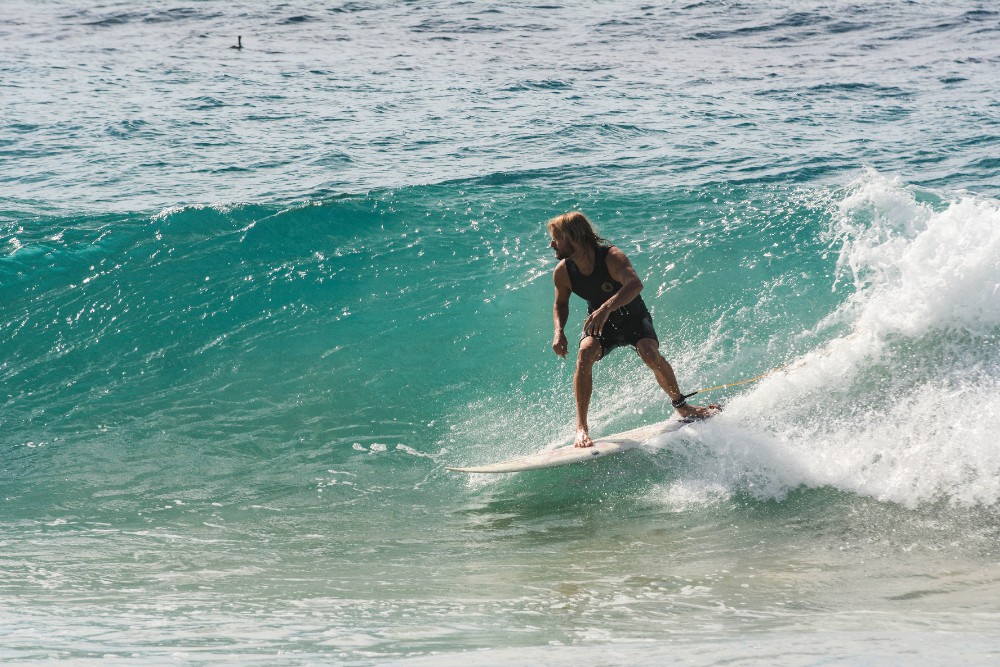
4. Practice your pop-up technique on your First Surf Lesson
5. Learn about water safety: Rip currents
How to Escape Safely From A Rip Current

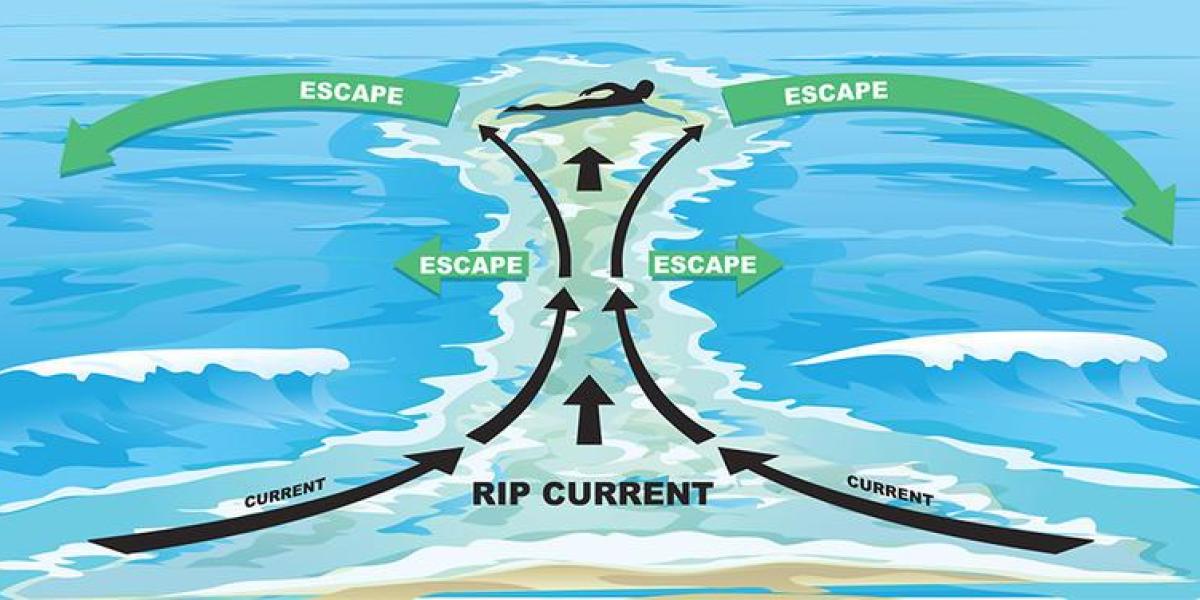
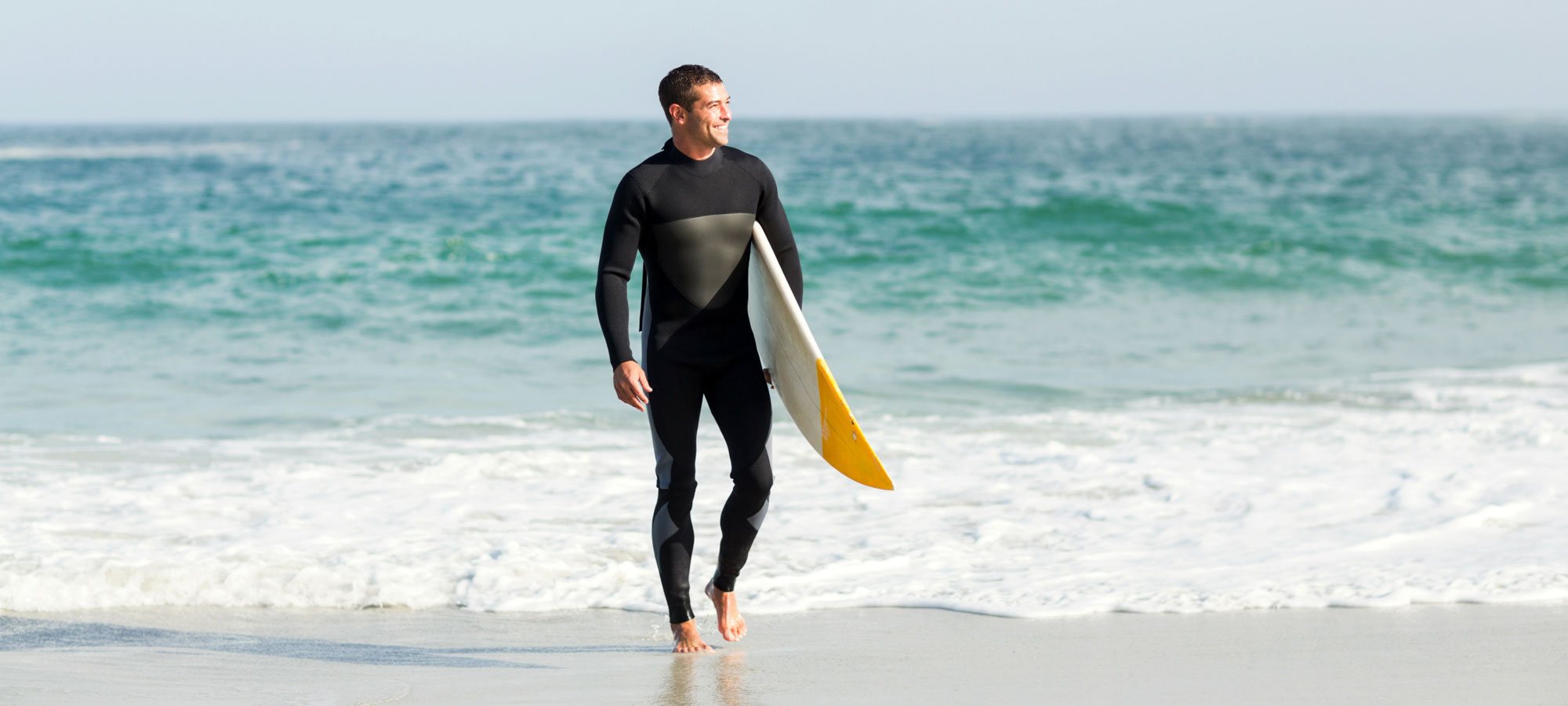
6. Appropriate Surfing Attire and Sunscreen on your First Surf Lesson
Wetsuit for surfing
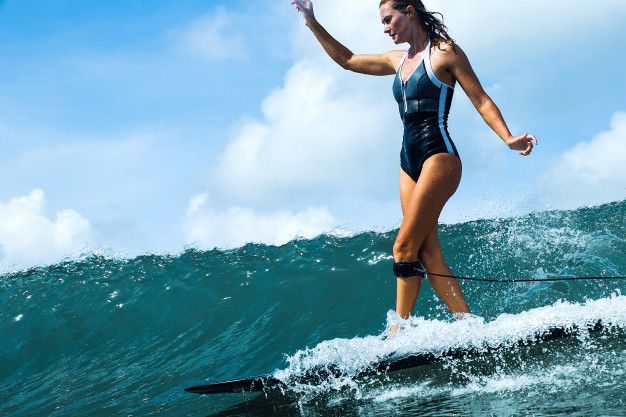
Swimsuit for surfing

Sunscreen for surfing
Use a different sunscreen for your face
7. Maintain A Healthy Diet
8. Read to get familiar with your First Surf Lesson common terms
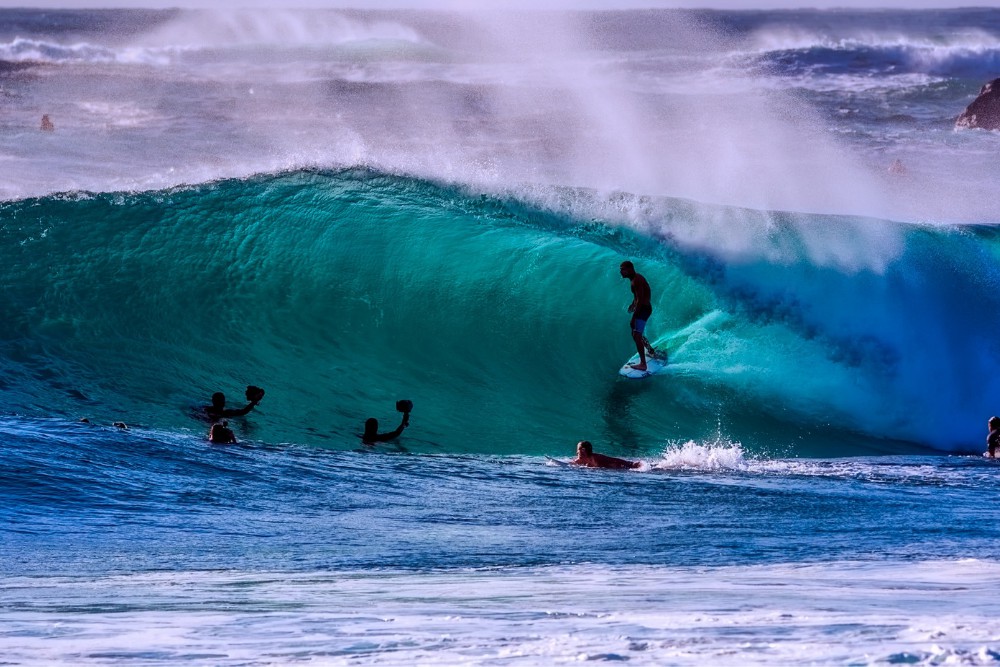
9. Plan Your Surf Trip and First Surf Lesson in Advance
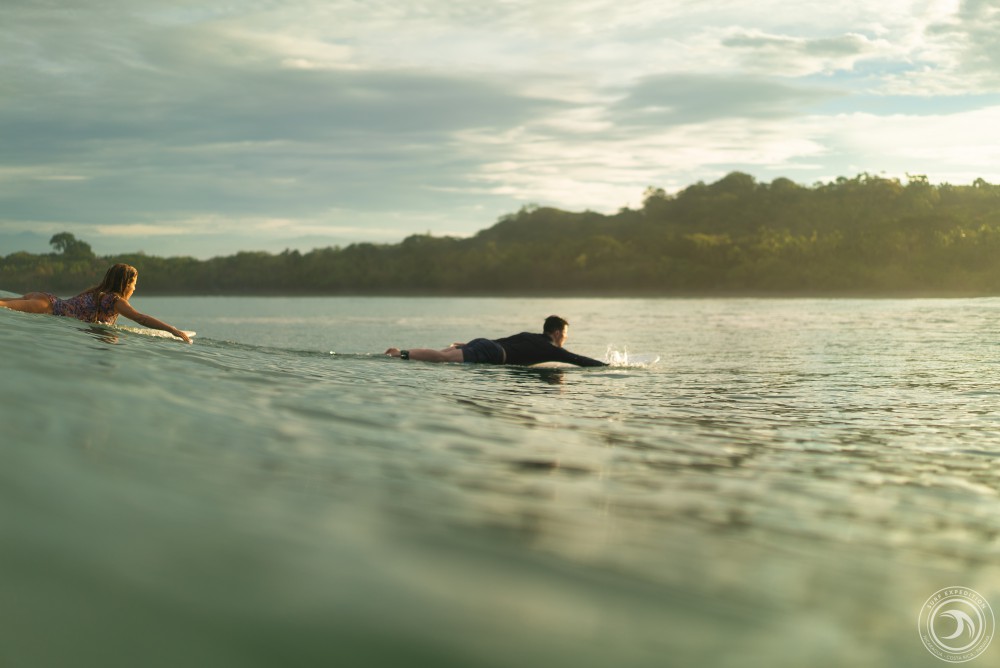
Keeping the water temperature in mind
Think about what kind of experience you want
10. Stay Close To Your Pack
Find Information about your surf spot
Key Takeaway
